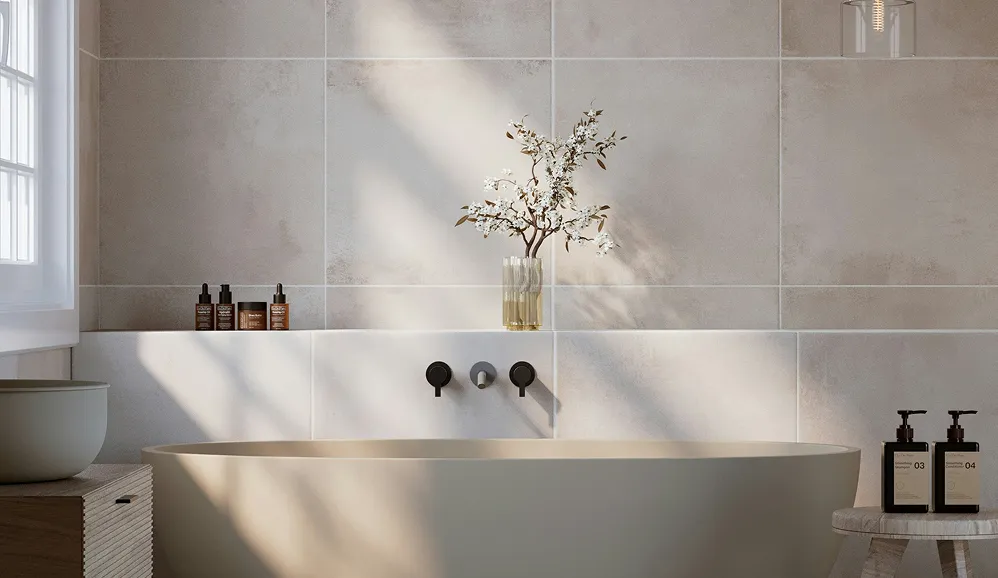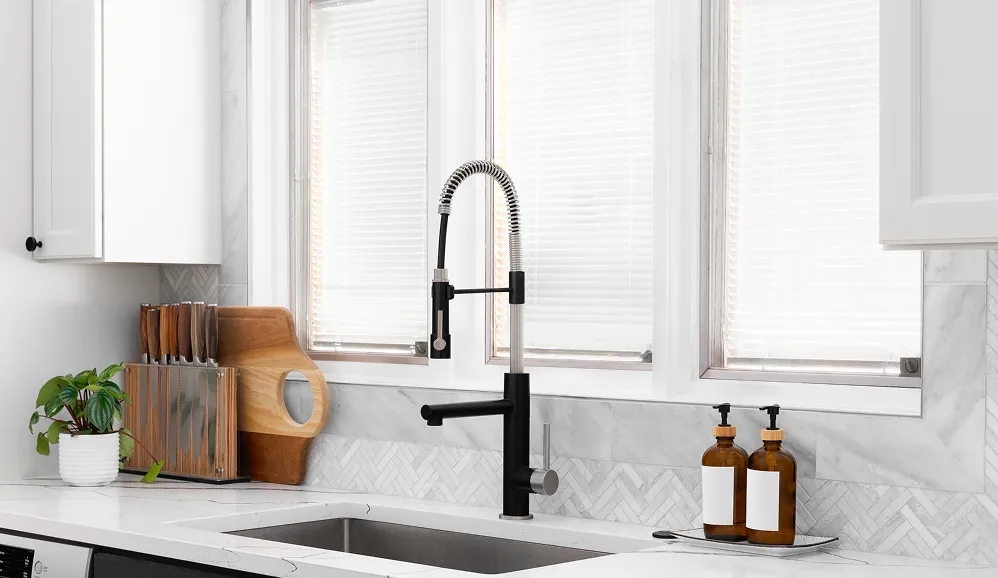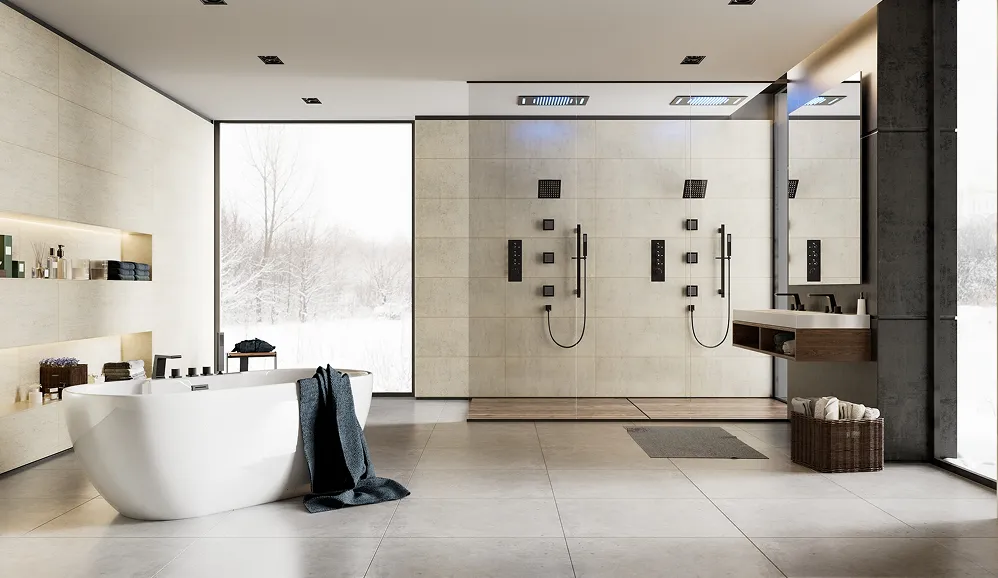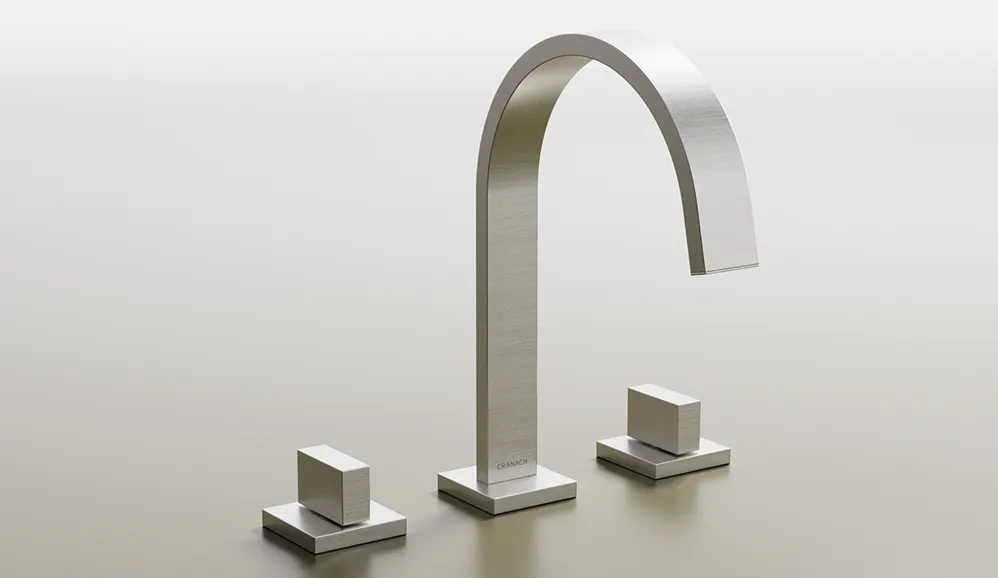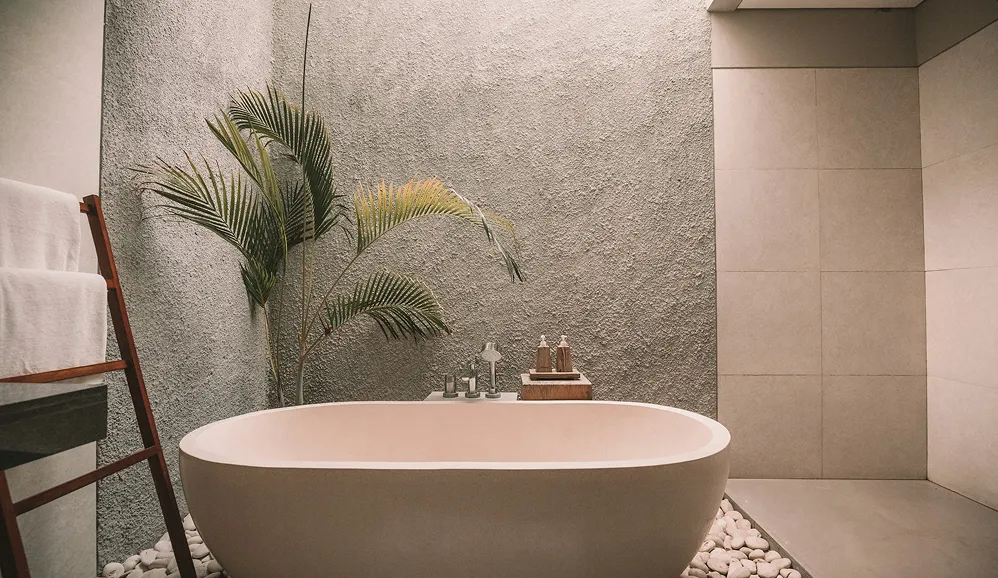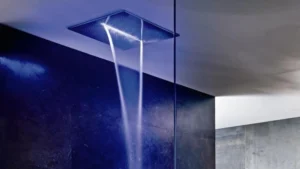On average, a single shower in the U.S. uses about 17 gallons of water. But that number is just a starting point—think of it like a car’s “miles per gallon.” Your actual water usage can swing wildly depending on your shower head and, of course, how long you like to linger under the warm spray.
Your Shower’s Hot Water Use Explained
It’s easy to lose track of just how much water goes down the drain when you step into the shower. While the national average gives us a useful benchmark, the real story is in the details of your own home. Understanding what drives that number is the first step to getting a handle on your water and energy bills.
The two biggest players are no surprise: how long you shower and your shower head’s flow rate.
A quick, 5-minute rinse is worlds apart from a long, 15-minute steam session. That might seem obvious, but the difference adds up faster than you’d think. As a nation, Americans use a staggering 1.7 trillion gallons of water every year just for showering. For one person showering six times a week, that can easily top 5,300 gallons annually.
How Water Usage Adds Up
The other half of the equation is your shower head’s flow rate, measured in gallons per minute (GPM). Older, less efficient fixtures could be dumping as much as 5 GPM, while modern, water-saving models are designed to use 2.5 GPM or even less. A high-quality rain shower head with handheld sprayer, for example, can deliver that luxurious, spa-like feel while still being mindful of water use.
To see how these two factors work together, let’s look at some real numbers.
The simple truth is that every minute you shave off your shower time directly translates into gallons saved. Pairing a shorter shower with an efficient fixture is the most effective way to lower your utility bills without sacrificing comfort.
The table below gives a quick snapshot of how fast water usage can climb, depending on your shower head.
Estimated Shower Water Usage by Flow Rate and Duration
This table provides a quick estimate of the total gallons of water used during a shower based on common shower head flow rates and different shower lengths.
| Shower Duration (Minutes) | Standard Shower Head (2.5 GPM) | Water-Saving Shower Head (1.8 GPM) |
|---|---|---|
| 5 Minutes | 12.5 Gallons | 9 Gallons |
| 8 Minutes | 20 Gallons | 14.4 Gallons |
| 10 Minutes | 25 Gallons | 18 Gallons |
| 15 Minutes | 37.5 Gallons | 27 Gallons |
Even small changes, like cutting a few minutes off your shower or switching to a more efficient fixture, can lead to some serious savings over the course of a year.
If you’re ready to get a better sense of your own habits, you can learn more about how many gallons of water a shower uses and start taking control of your consumption. This knowledge is power—it lets you make smarter choices for both your wallet and the planet.
The Three Levers Controlling Your Water Bill
To really get a handle on how many gallons of hot water a shower uses, it helps to think of it like this: every time you step into the shower, you’re in control of three main levers. Each one has a direct say in what your water and energy bills look like at the end of the month. Getting to know these levers is the secret to cutting back on consumption without giving up that comfortable, relaxing shower you look forward to.
The most straightforward lever is, of course, shower duration. This is just the raw amount of time you spend with the water running. An extra five minutes might not feel like a big deal, but with a standard shower head, that can easily tack on over 12 gallons of water to your daily total. It’s the most direct and impactful factor you control.
Flow Rate and Water Temperature
Next up is your shower head’s flow rate, which we measure in gallons per minute (GPM). You can think of this as how wide the tap is cranked open. An old, inefficient fixture is basically a fire hose, gushing out far more water than you actually need. On the other hand, a modern, high-efficiency fixture like the Crozet Shower Kit, with its rain shower head and handheld sprayer, is engineered to give you that powerful, satisfying spray while using a whole lot less water.
Switching to a water-saving shower head is one of the easiest wins for any household. The EPA estimates that an average family can slash its water bill by more than $70 annually and save thousands of gallons of water just by making this one simple upgrade.
The final lever is the water temperature. We all love a steaming hot shower, but cranking up the heat forces your water heater to work overtime and pulls almost exclusively from the hot water line. This isn’t just about using more energy to heat the water; it also means you’re consuming a higher total volume of hot water specifically.
Once you understand how these three factors play together, you can make small tweaks that lead to big savings without feeling like you’re making a sacrifice.
- Duration: Try cutting your shower time by just one or two minutes. You’d be surprised how much that adds up.
- Flow Rate: Make the switch to a WaterSense-certified shower head. Look for one with a flow rate of 2.0 GPM or less.
- Temperature: Dial back the heat just a little. It eases the burden on your water heater and your wallet.
Find Out Your Shower’s Exact Water Footprint
Enough with the averages and estimates. Let’s figure out exactly what your shower is using. It’s surprisingly simple. All you’ll need is a 1-gallon bucket (or any bucket where you know the volume) and a stopwatch—your phone’s will do just fine.
This quick little experiment is what we call the “bucket test,” and it’s the best way to find out your shower’s true gallons per minute (GPM) flow rate.
First, just place the bucket directly under your shower head. Then, turn on the water to the pressure and temperature you normally would and start your stopwatch at the exact same time. The moment the bucket is full, stop the timer.
Think of this test as turning abstract numbers into real, personal data. It takes the guesswork out of how many gallons of hot water a shower uses and shows you exactly what’s happening in your own home.
The Simple Math for Your Shower’s Water Use
Got your time? Great. Now let’s translate that into a GPM rating. The formula is easy: divide 60 by the number of seconds it took to fill the bucket.
For example, if it took you 24 seconds to fill your 1-gallon bucket, you’d divide 60 by 24. That gives you a flow rate of 2.5 GPM. If it filled up in just 15 seconds, your flow rate is a much higher 4.0 GPM.
A low number is great for water savings, but if your shower feels more like a drizzle than a downpour, you might want to look into how you can increase water pressure in your shower.
To make this even easier, I’ve put together a little table you can use to track your own results and do the math. Just grab a pen or open a notes app and follow along.
DIY Shower Flow Rate Test Results
| Step | Instruction | Your Measurement |
|---|---|---|
| 1 | Time (in seconds) it took to fill a 1-gallon bucket. | e.g., 24 seconds |
| 2 | Divide 60 by the time you measured in Step 1. | 60 ÷ 24 = 2.5 |
| 3 | This is your shower’s GPM (Gallons Per Minute). | 2.5 GPM |
Now that you have your own personal GPM, you have the key to understanding your water consumption. It’s the most important piece of the puzzle.
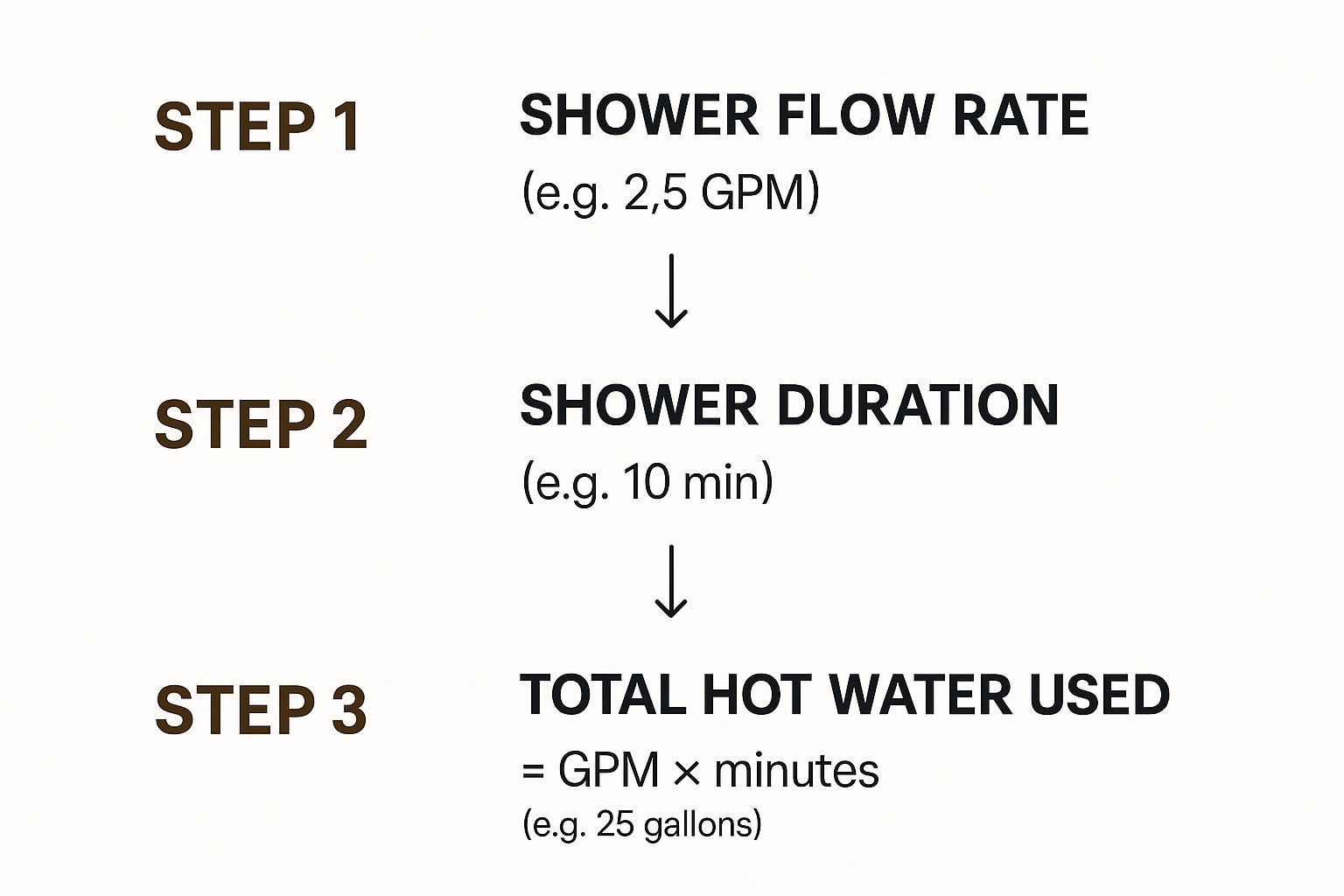
As the infographic shows, you can now use a straightforward formula to calculate your total usage for any shower:
Your GPM x Shower Length in Minutes = Total Gallons Used Per Shower
This isn’t just a number; it’s a powerful tool. Knowing your exact usage gives you a clear starting point, empowering you to make smart, informed decisions about how you use water at home.
How Your Shower Head Secretly Drives Up Costs
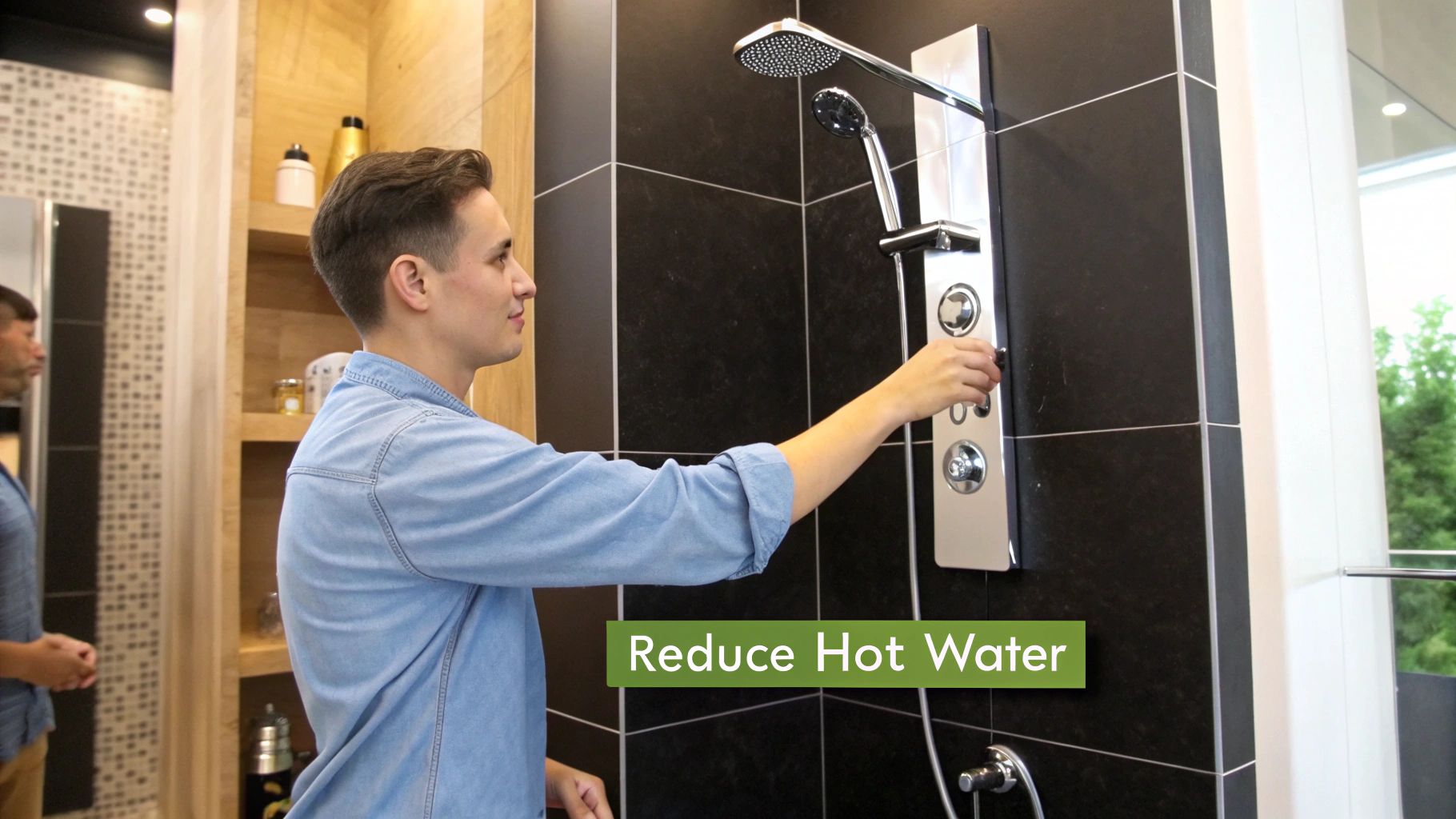
While your daily habits play a big part, the single biggest factor gobbling up water in your shower is often the hardware itself. An old, outdated shower head can be a hidden budget-breaker, gushing out 5 gallons per minute (GPM) or even more. That’s a massive amount of water going straight down the drain.
In stark contrast, a modern, EPA WaterSense-certified model is engineered to use 2.0 GPM or less. The difference between a 5 GPM relic and a 2.0 GPM fixture might not sound like much, but it can easily add up to thousands of gallons and hundreds of dollars wasted each year.
Efficiency Without Compromise
Fortunately, upgrading your shower head doesn’t mean you have to settle for a weak, unsatisfying drizzle. Modern engineering has completely changed the game, proving you can have a luxurious experience while still being responsible with water.
Advanced designs, like a high-efficiency rain shower head with handheld attachment, are a perfect example. These systems deliver that immersive, full-coverage spray you love while using significantly less water than their older counterparts. It’s the best of both worlds: the spa-like feel of a rain shower and the practical flexibility of a handheld sprayer, all designed for conservation.
The Environmental Protection Agency (EPA) estimates that the average shower uses about 2.1 gallons of water per minute. But an inefficient shower head can cause this to skyrocket to 5 GPM, turning a simple 8-minute shower into a 40-gallon event.
Making the switch is one of the quickest ways to see a real drop in your water and energy bills. It’s an investment that pays for itself over time through lower utility costs. To keep your new fixture running perfectly, it’s also a great idea to learn how to clean your shower head with vinegar, which stops mineral buildup from disrupting the flow.
Ultimately, understanding how many gallons of hot water a shower uses starts by looking at the fixture. An efficient shower head is the foundation of a water-smart bathroom, giving you control over your consumption without sacrificing the comfort of a great shower.
Simple Habit Changes for Big Water Savings
Understanding the numbers behind your shower is half the battle; the other half is all about your daily habits. Slashing how many gallons of hot water a shower uses doesn’t mean you have to make a huge sacrifice. In reality, a few small, mindful tweaks to your routine can make a surprisingly big difference on your water and energy bills.
These strategies go way beyond just setting a timer. They’re proof that being conscious of your habits can be just as powerful as installing efficient hardware when it comes to creating a more sustainable home.
Adopt Smarter Showering Techniques
One of the easiest and most effective methods is the “navy shower.” It’s simple: you turn off the water while you lather up with soap or shampoo, then turn it back on to rinse. You get just as clean, but you can effortlessly cut several minutes—and gallons of wasted water—from every single shower.
Here’s another simple change: check your water heater’s thermostat. Many are set to 140°F right out of the box, but lowering it to 120°F is still perfectly hot for most families. This small adjustment reduces standby energy loss, meaning your heater isn’t working overtime just to keep water at a scalding temperature you don’t even need.
It’s also critical to promptly fix a leaky faucet or that annoying dripping shower head. A single drip per second might not seem like much, but it can waste over 3,000 gallons per year—that’s enough water for more than 180 showers!
Combine Habits with Efficient Hardware
While these habit changes are powerful on their own, they become absolute game-changers when you pair them with the right equipment. If you’ve already made the switch to an efficient fixture, these habits will amplify your savings even more.
Each of these tips is a small, manageable change you can start today:
- Try a “Navy Shower”: Turn the water off while you’re lathering up.
- Lower Your Thermostat: Check your water heater and set it to 120°F.
- Fix Drips Immediately: Don’t let those small leaks turn into major water waste.
If you’re interested in taking the next step with hardware, you can learn all about the benefits of a low-flow shower head in our detailed guide. Combining smarter habits with efficient technology is the ultimate strategy for shrinking your home’s water footprint.
Common Questions About Shower Water Usage
After digging into all the numbers, a few more questions might be bubbling up. It’s only natural. Once you start thinking about how many gallons of hot water a shower uses, you get curious about your daily habits and the hardware in your bathroom. Let’s clear up a few common points to help you make even smarter decisions.
One of the oldest debates in the book: which uses more water, a bath or a shower? While a long, luxurious shower can definitely guzzle water, a standard bath typically needs 30 to 50 gallons just to fill up. In most situations, a mindful shower—especially one under 10 minutes with an efficient fixture—is going to use far less water than a full bath.
Are All Rain Shower Heads Water Hogs?
It’s a common myth that rain shower heads are all wasteful water hogs. Older models might have deserved that reputation, but modern fixtures are a completely different story. A high-quality rain shower head with handheld sprayer can give you that incredible, full-body spray while still meeting or even beating federal efficiency standards. They are engineered to create the feeling of a deluge, not the reality of one.
The secret isn’t in the style, but in the engineering. Many of the best models use clever aeration techniques or precisely designed nozzle patterns to deliver a deeply satisfying shower with a surprisingly low flow rate.
The connection between hot water use and your energy bill is direct and significant. Heating water is typically the second-largest energy expense in a home after heating and cooling. Every gallon of hot water you save is also a direct reduction in the energy your water heater consumes.
This link between water and energy is exactly why a little conservation in the bathroom goes such a long way. Showers and baths make up nearly 19 percent of an individual’s indoor water use. With water demand on the rise globally, trimming down how much we use in the shower is a huge step for both your wallet and the planet.
Finally, you might be wondering if a more elaborate routine, sometimes called an “everything shower,” completely torpedoes your water-saving goals. While it’s true that longer showers will always use more water, you can learn more about how to manage an everything shower routine without seeing a massive spike on your utility bills. It’s all about striking a balance between self-care and smart consumption.
At Cranach, we believe you shouldn’t have to choose between a luxurious experience and an efficient home. Our shower systems are designed to provide a powerful, relaxing spray while helping you conserve water and energy. Discover the perfect blend of style and sustainability with the Crozet Shower Kit 10″ Round Rain Shower Head with Handheld.

